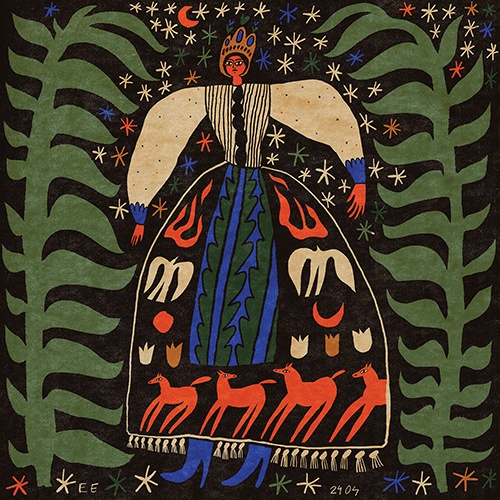 Illustration by Enikő Eged
Illustration by Enikő Eged
One Spell Fits All
When witchcraft makes its way onto retail shelves and websites, some wonder whether the magic is lost.
I was about fourteen when I first wandered into a local occult shop. Entranced by the glittering crystals in the windows and the plumes of incense wafting from the open door, I walked inside and my eyes widened. Shelves packed with tarot cards and spiritual books filled the small space. For the first time in my relatively sheltered Roman Catholic life, I’d come face to face with modern witchcraft. I felt like I was seeing something I wasn’t meant to see, like someone would be upset with me for entering the shop. Regardless, I pressed on.
I left the store with a polished amethyst pendulum and a mini deck of Celtic tarot cards. I’d found myself drawn to the pendulum’s bright purple stone, and to the tarot deck’s illustrations, drawn in painstaking detail and brought to life with deep, evocative colours. Walking home with my purchases stowed in my bag and the sun beating down on me, I felt giddy and rebellious. I also felt a bit like a fraud. It had only been two or three years since I had stopped going to church every Sunday, and over the years, I’d spent a good chunk of my free time volunteering as a Bible camp counsellor and youth group leader. Something inside told me that I was committing a cardinal sin—but a larger part of me felt called to what I didn’t understand. Deep down, I knew that Catholicism had never really sat right with me. My desire to find something that I believed in was stronger than my fear of burning in hell for eternity.
After I arrived home, I got straight to work, spending hours poring over the Bible-paper-thin pages of the tiny book that came in the tarot box. I committed the cards and their meanings to memory: the Ten of Pentacles, representing the passage of time; the King of Swords, symbolizing willpower; the Three of Wands, signifying the desire for the unknown. As the months passed and my interest in witchcraft grew, I took to the internet, reading about spells and rituals on blogs. I began scouring my parents’ cupboards for dried herbs, salts and tea lights. I had little money of my own, so buying anything myself was out of the question. I had only my wits and my meagre ideas of what witchcraft looked like.
I pieced together a practice by getting creative. Instead of digging a hole in the backyard to bury the ingredients of a spell, I would put the materials in a tea bag, fill it with dirt, seal it and slip it into the compost bin. I traded harder-to-find herbs for common plants, like mullein for thyme, which provide similar protective energies. I used paint and pencil crayons on white tea lights to create makeshift coloured candles. In lieu of an incense dish, I burned herbs in pots and pans. At the time, I felt as though my haphazard mishmash of a practice was shabby and embarrassing. Unbeknownst to me, this was actually the best way I could have learned—by altering spells and substituting ingredients to fit my needs, I was creating a practice that was entirely my own.
Modern witchcraft is a broad term that covers a variety of individualized practices related to spells, rituals and magic. It is closely associated with Wicca, a nature-based religion that attracted public attention in the 1950s. Unlike many of today’s major religions, Wicca is typically practiced according to an individual’s personal rules. While there are some core beliefs, such as the presence of the divine in nature, Wicca can largely look however a practitioner wants it to. Common Wiccan practices include casting spells, engaging in rituals to celebrate the seasons or moon phases, and worshipping deities like the Horned God and the Triple Goddess, which represent the divine masculine and the divine feminine respectively.
Wicca falls under the umbrella of paganism, a term used to describe a diverse group of spiritual and religious beliefs that are typically connected to nature and the Earth. Some pagans engage in witchcraft as part of their practice. Sabina Magliocco, a lecturer in socio-cultural anthropology at the University of British Columbia, says that Wicca, other pagan traditions and witchcraft place greater importance on practice than belief. “They are not at all about dogma,” she says. The lack of authorities or strict rules means that anyone can dip their toes into these worlds without a formal blessing or introduction. Newcomers might attend classes offered by other witches, or gather their first supplies at local occult shops run by established practitioners. The accessibility of these practices can make them particularly appealing to people who are tired of the dogmas of major religions and want a change, or to people who feel lost and are looking for guidance.
Today, there is a growing number of people in Canada who identify with pagan practices. Statistics Canada’s 2011 National Household Survey found that over twenty-five thousand Canadians identified as pagan. As of the 2022 census, the number of pagans had almost doubled to more than forty-five thousand people, including over twelve thousand Wiccans. These statistics likely do not represent the actual number of practicing witches, because not all witches consider themselves pagan or Wiccan, and vice versa.
In recent years, the commodification of witchcraft has accelerated. Companies hovering on the sidelines are trying to make some quick money off new practitioners. Indigo sells a variety of witchcraft books, tarot decks and oracle card sets. Walmart advertises healing crystal pendulums. Amazon and Temu both offer a wide range of witchcraft kits, with names like the “Bohemian Crystal Kit” and the “Avant-Garde Loose Gemstones and Smudge Kit.” Hot Topic, the counterculture clothing and accessories shop commonly found in malls, has hawked packs of incense, as well as a box of healing stones and a healing amethyst necklace.
Wares like these that fill retailers’ shelves and websites may seem to offer an easy entry point into witchcraft. Many of these products’ messaging suggests that newcomers can become witches simply by purchasing them. But large companies are appropriating the practice by turning freely accessible knowledge into objects to be sold for profit. At its core, witchcraft is a deeply personal practice that is driven by a practitioner’s feelings and intuition. The proliferation of these mass-produced goods encourages newcomers to keep buying new kits and tools, rather than engage with their beliefs or seek guidance from other witches. When retail chains put a price tag on witchcraft, they undermine the very foundation of a practice that is based on self-discovery and inner power.
Witchcraft has long been misrepresented and vilified by mainstream society. There are records of witch hunting that date back to the second century BC in Rome and the surrounding areas. Beginning around the fifteenth century, there was a rise in hysteria around witches, and in witch hunts and trials, in Europe. This hysteria was encouraged by the Catholic Church’s view of witchcraft as heresy. According to some historians, folk medicine practitioners who brought plant-based remedies to townspeople, and midwives who assisted with labour and pain during childbirth, were often at risk of being accused of witchcraft. These predominantly women healers were sometimes at odds with the wider male-dominated religious and medical communities. Some of their practices, such as the use of charms and incantations, were seen as opposing the Church. There was also a push toward licensure and the prioritization of formally educated male physicians, which marginalized unlicensed women healers.
Those accused of witchcraft would often be tortured until they confessed, and many people lied in order to avoid death. These punishments and the spread of accusations exacerbated the climate of fear. Between 1692 and 1693, the tension came to a head in colonial America with the infamous Salem witch trials, during which nineteen victims were convicted of practicing witchcraft and hanged in what is now Massachusetts. Many others were imprisoned. For a long time, stereotypes and notions that witches were evil and to be feared continued to exist in Europe. The last documented execution for the crime of witchcraft on the continent took place in the late 1700s.
When Wicca emerged in the public sphere in the 1950s, it was still a fairly secretive practice. Wiccans were typically part of groups called covens, and members would practice together and form strong bonds with each other. In a 2023 article in the Conversation, sociologist Helen A. Berger explains how in the early days of modern witchcraft, local occult shops would sell tools like crystals and coloured stones. In the eighties, the introduction of how-to books about Wicca kick-started the commercialization of witchcraft. The increased availability of written guidelines opened the practice up to many more people. Over the next few decades, this process accelerated, and training courses, magazines and websites geared toward practitioners entered the scene.
This shift away from education through covens made witchcraft more accessible, but it also transformed its nature. When you’re part of a coven, the focus isn’t solely on developing your solo practice, but on learning from those around you and growing together. When information comes from a profit-driven enterprise, this dynamic changes, and covens’ aspect of emotional connection is lost. Douglas Ezzy, an Australian sociologist who specializes in modern religion, writes about this change in a 2001 article in the Journal for the Academic Study of Religion. Ezzy explains how commodified witchcraft is all about profit and getting people to spend more. According to his research, many websites about witchcraft that focus on encouraging visitors to buy products seem to prey on people’s loneliness and isolation. Rather than trying to assist individuals in their spiritual self-growth, these websites frequently present purchases as solutions.
The commodification of witchcraft has only intensified in recent years as big brands try to take advantage of growing interest in the practice. One of the most egregious examples was Sephora and fragrance company Pinrose’s “Starter Witch Kit,” which was set to launch in 2018. The kit would’ve included a tarot deck, mini bottles of fragrances, a bundle of sage and a chunk of rose quartz. Many witches took to social media to call the brands out for capitalizing on the aesthetic of witchcraft and trying to make money off of their practice. Critics also pointed out the kit’s planned inclusion of white sage, a plant that is sacred to many Indigenous people. It can be used for cleansing and purification purposes as part of a ceremony known as smudging. The practice was historically banned by colonial governments and continues to be a basis for anti-Indigenous discrimination. By selling sage to the masses, Sephora and Pinrose would have appropriated and profited from an Indigenous spiritual practice.
In response to the backlash, the “Starter Witch Kit” was cancelled. But this controversy did not stop major retailers from selling occult products. Today, you can easily find pre-made altars on Amazon. For many witches, an altar is their sacred space; it is where they meditate, cast spells and engage in rituals and worship. Each practitioner’s altar typically contains the tools and talismans they have accumulated over the course of their practice. Mass-produced altars—decked out with coloured candles, crystals, packets of dried herbs and accessories like bells or altar cloths—erase this personalization. They can leave practitioners with a weak relationship to their altar, which is one of the places where witches are supposed to feel the most connected to their practice.
For Kendra and Jessica Pape-Green, co-owners of Witch Plz, a metaphysical supply store in Innisfil, Ontario, the commodification of witchcraft is a nuanced issue. The availability of these products can help more beginners access the practice, particularly if they live in areas without an occult shop or witch community. While these items might not have been the most well-researched or have been developed mindfully, they may be the only way for a beginner to start on their path. “They might just be trying something out and it could strike ... deep at their core,” says Jessica. “They deserve to have that introduction.”
But the modern “witchy” products sold by major retailers often rely on predatory branding. Many of these products are marketed using an approach common to lifestyle brands, promising to solve people’s problems and help them achieve a certain way of life. One tarot kit available at Indigo assures buyers that they will “never be at a loss for answers and guidance to [their] most pressing questions” if they have the tarot deck and accompanying guidebook. A healing crystal kit previously sold on Walmart’s website claims that the heart-shaped crystals will “generate exceptional energy” and allow energy to flow through the heart chakra. (Interestingly enough, the pictured crystals are not heart-shaped.) Other witchcraft starter kits frequently present grand claims and come with detailed instructions. This one-size-fits-all approach makes it seem as though there is only one correct way to practice witchcraft, and that products will fulfill all of the customer’s desires. It discourages practitioners from doing their own research, trusting their intuition and coming up with practices of their own.
The focus on commodities might trap some beginners in a loop of constantly buying new products. Retailers encourage this by luring customers into purchasing separate items to address different aspects of their lives. For example, someone looking to attract wealth might peruse Amazon’s website and come across the “Luck Spell in a Box” kit. The kit is equipped with three light-green candles, a candle holder and a set of instructions. When another problem emerges in this person’s life—perhaps they want to improve their love life, or shield themselves from negative energy—they may be tempted to purchase the “Love Spell in a Box” kit or the “Protection Spell in a Box” kit. The focus is on getting consumers to buy more, rather than on encouraging them to solve problems by themselves. This cycle of consumerism stops people from developing a personal connection to the practice.
Witchcraft is meant to change and morph based on the practitioner. It should be thought of as a piece of wet clay on a potter’s wheel. Each person who comes into contact with it will develop the practice in a way that is personal to them and that can’t be perfectly recreated by anyone else. Corporations frame witchcraft, instead, as something that has already been fired in the kiln: solid, unchanging and not able to be reshaped. This vision of witchcraft denies practitioners access to the core of the practice—the opportunity to develop something that is unique and true to themselves, and that cannot be bought or sold.
A core tenet of Wicca and paganism is building a relationship with the universe and with nature, which takes time and effort. When you can order products from your home and have them arrive at your door the next day, the importance of getting to know yourself, your tools and your surroundings can be lost.
Andra Zlatescu is an Ontario-based ancestral witch who practices magic tied to their ancestors and birthplace. They say that mass-produced items that are sold using lifestyle branding often disempower people from developing connections with the land they occupy and with each other. “It is really beautiful and sacred to make your own tools and be gifted your tools from relationships with the land and with other people,” they say. Taking the time to foster connections with plants and herbs can also help witches use them to their full potential during rituals.
While reading and following a little guide in a retailer’s kit might be fun and make someone feel better for a moment, there is often little personal development taking place. Such a product tends to present witchcraft as neat, tidy and easy to navigate. This should not be the case; witchcraft should require doing heavy lifting and potentially uncomfortable emotional work. Creating a version of witchcraft that can be written into a brief summary, boxed up and mass-produced takes all the life and personality out of a practice that should change and develop with each practitioner.
Being a witch has always been a radical way to live. Many witches believe that their power is inherent to them, and that no one can control it or take it away. This opposes mainstream Christian beliefs, which generally give all power to God and present people as subject to his will. Witches’ conviction of their innate power also challenges the focus on commodities. Growing your own herbs, trading goods and making tools like candles and ashtrays by hand are all ways that witches can harness their skills and resist consumerism. These small acts of reclaiming power and control from a capitalist system are the very fabric of witchcraft.
A good way for a beginner to start is to look inside themselves. What are they good at? What makes them feel safe? An artist can incorporate painting or drawing into their practice. A cook can begin with kitchen magic. “The idea that we can influence the world around us by doing simple things—lighting a candle, chanting a spell—is very creative,” says Magliocco. “Magic is, in fact, an art form.” By focusing on yourself and what makes you feel good, you have the beginnings of a practice.
When I was younger, I felt so self-conscious about my witchcraft. My tiny, bare-bones altar was hidden in a hand-me-down wooden vanity in my bedroom. Tucked away in the vanity’s creaky, green velvet-lined drawers were most of my witchcraft supplies: Ziploc baggies of kitchen herbs, handfuls of crystals, cards and candles. Most of my tools were handmade, and almost every spell and ritual I did needed to be changed to fit my circumstances. I felt like I wasn’t working hard enough at my practice. I thought that if I really cared, I’d shell out the funds to gather some authentic tools and become a “real witch.”
Now, I wish other beginners could experience the introduction to witchcraft that I had. Looking back, I realize that no one practiced exactly the way I did. I found things that worked for me over time. I quickly learned that instead of using hand-painted tea lights, I could buy coloured tapered candles, which are a dime a dozen at a local thrift store. There may be less adult colouring involved, but it certainly helps to have candles that don’t weep paint when you burn them. I picked up cheap ashtrays to burn herbs in, and pans are now significantly less likely to wind up under my bed. I still use the tea bag hack, because it’s not always realistic to dig holes in the backyard.
When I feel called to do a reading for something important in my life, I always go back to the Celtic tarot deck I bought when I was fourteen. The amethyst pendulum I picked up on that fateful day all those years ago has since broken and been replaced, but the pendulum remains my favourite tool, and the one I use most often. In a way, it represents my relationship with witchcraft and how my practice has developed over the almost ten years since I stumbled into that occult shop. Sometimes I swing one way, and I’m doing readings every other day and casting spells in my bedroom. Other times, I’m too bogged down and busy to be bothered. When I do feel that string tugging at my mind, pulling me to the unknown like it did all those years ago, the first thing I do is shut my eyes and look inside. ⁂
Hannah Mercanti is a writer and fact-checker based out of Hamilton, Ontario. They are a recent graduate of Toronto Metropolitan University’s School of Journalism, with a focus on literature and queer communities.





